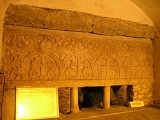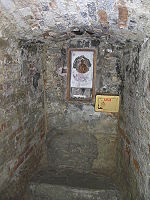
Hilary of Galeata
Encyclopedia
Saint Hilary of Galeata (Italian: Sant'Ilaro or Sant'Ellero; 476 - May 15, 558 AD) is venerated as a saint
in the Roman Catholic and Eastern Orthodox
churches. His feast day is May 15.
According to tradition, he was born in Tuscia
in 476, and he decided to dedicate himself to the life of a hermit
at the age of twelve. He left his home, and traveled across the Apennines towards Emilia
and chose a spot, according to tradition, pointed out to him by an angel
, on a mountain in the valley of the Bidente near the Ronco River
. According to tradition, at the age of twenty, he freed a local nobleman, Olibrius, from a demon. In gratitude, Olibrius had his entire family christened by Hilary, and donated to the saint lands and money. In addition, two of Olibrius’ sons joined Hilary in the religious life. Around 496, then, this became the nucleus of the monastery of Galeata
, later called Sant'Ellero di Galeata. The foundation attracted new recruits, and the monastery followed a version of the rule of Saint Pachomius. Numerous miracles are attributed to Hilary. Hilary transformed a grape into a serpent in order to teach a lazy monk named Glicerio a lesson. Hilary also managed to impress Theodoric
, who had originally been harassing the monks and who had been building a palace near Galeata, into donating land and goods.

, which called for the incorporation of miracles, the active participation of angels and demons, and the addition of long, devout speeches and prayers in the text. In addition, Lucchesi points out that the story of Olibrius’ liberation from demonic possession
is a trope
found in another hagiographies of the time (such as those associated with Saints Apollonia
, Gordian, Cyriacus
, Epiphanius
, Potitus, Abercius
, Vitus, etc.).
Hilary’s cult was diffused across Tuscany
and Romagna
, especially in the dioceses of Arezzo
, Sarsina
, Forlì
, Bertinoro
, Faenza
, Imola
, Modigliana
, Fiesole
, Florence
and at the abbey of Farfa
.
Sant'Ellero di Galeata subsequently became a Camaldolese
monastery.
Saint
A saint is a holy person. In various religions, saints are people who are believed to have exceptional holiness.In Christian usage, "saint" refers to any believer who is "in Christ", and in whom Christ dwells, whether in heaven or in earth...
in the Roman Catholic and Eastern Orthodox
Eastern Orthodox Church
The Orthodox Church, officially called the Orthodox Catholic Church and commonly referred to as the Eastern Orthodox Church, is the second largest Christian denomination in the world, with an estimated 300 million adherents mainly in the countries of Belarus, Bulgaria, Cyprus, Georgia, Greece,...
churches. His feast day is May 15.
According to tradition, he was born in Tuscia
Tuscia
Tuscia is a historical region of Italy that comprised the southern territories under Etruscan influence. While it later came to coincide with today’s province of Viterbo, it was originally much larger, including the whole Region of Tuscany, a great part of Umbria and the northern parts of...
in 476, and he decided to dedicate himself to the life of a hermit
Hermit
A hermit is a person who lives, to some degree, in seclusion from society.In Christianity, the term was originally applied to a Christian who lives the eremitic life out of a religious conviction, namely the Desert Theology of the Old Testament .In the...
at the age of twelve. He left his home, and traveled across the Apennines towards Emilia
Emilia (region of Italy)
Emilia is a historical region of northern Italy which approximately corresponds to the western and north-eastern portions of today’s Emilia-Romagna region...
and chose a spot, according to tradition, pointed out to him by an angel
Angel
Angels are mythical beings often depicted as messengers of God in the Hebrew and Christian Bibles along with the Quran. The English word angel is derived from the Greek ἄγγελος, a translation of in the Hebrew Bible ; a similar term, ملائكة , is used in the Qur'an...
, on a mountain in the valley of the Bidente near the Ronco River
Ronco River
The Ronco is a river of Italy, a tributary of the Montone. The Battle of Ronco took place here.-References:...
. According to tradition, at the age of twenty, he freed a local nobleman, Olibrius, from a demon. In gratitude, Olibrius had his entire family christened by Hilary, and donated to the saint lands and money. In addition, two of Olibrius’ sons joined Hilary in the religious life. Around 496, then, this became the nucleus of the monastery of Galeata
Galeata
Galeata is a comune in the Province of Forlì-Cesena in the Italian region Emilia-Romagna, located about 70 km southeast of Bologna and about 30 km southwest of Forlì....
, later called Sant'Ellero di Galeata. The foundation attracted new recruits, and the monastery followed a version of the rule of Saint Pachomius. Numerous miracles are attributed to Hilary. Hilary transformed a grape into a serpent in order to teach a lazy monk named Glicerio a lesson. Hilary also managed to impress Theodoric
Theodoric the Great
Theodoric the Great was king of the Ostrogoths , ruler of Italy , regent of the Visigoths , and a viceroy of the Eastern Roman Empire...
, who had originally been harassing the monks and who had been building a palace near Galeata, into donating land and goods.

Veneration
The author of Hilary’s Vita claims that he is a disciple and eyewitness to the events of the saint’s life. Scholars have declared it to be written contemporaneously with the life of Hilary. However, as Giovanni Lucchesi has remarked, the Vita’s author followed the normal standards for writing hagiographies in the Middle AgesMiddle Ages
The Middle Ages is a periodization of European history from the 5th century to the 15th century. The Middle Ages follows the fall of the Western Roman Empire in 476 and precedes the Early Modern Era. It is the middle period of a three-period division of Western history: Classic, Medieval and Modern...
, which called for the incorporation of miracles, the active participation of angels and demons, and the addition of long, devout speeches and prayers in the text. In addition, Lucchesi points out that the story of Olibrius’ liberation from demonic possession
Demonic possession
Demonic possession is held by many belief systems to be the control of an individual by a malevolent supernatural being. Descriptions of demonic possessions often include erased memories or personalities, convulsions, “fits” and fainting as if one were dying...
is a trope
Trope (literature)
A literary trope is the usage of figurative language in literature, or a figure of speech in which words are used in a sense different from their literal meaning...
found in another hagiographies of the time (such as those associated with Saints Apollonia
Saint Apollonia
Saint Apollonia was one of a group of virgin martyrs who suffered in Alexandria during a local uprising against the Christians prior to the persecution of Decius. According to legend, her torture included having all of her teeth violently pulled out or shattered...
, Gordian, Cyriacus
Saint Cyriacus
Cyriacus, or Cyriac, is a Christian martyr who was killed in the persecution of Diocletian. He is one of twenty-seven saints, most of them martyrs, who bear this name, of whom only seven are honoured by a specific mention of their names in the Roman Martyrology.-Life:Of the Saint Cyriacus who,...
, Epiphanius
Epiphanius of Salamis
Epiphanius of Salamis was bishop of Salamis at the end of the 4th century. He is considered a saint and a Church Father by both the Eastern Orthodox and Catholic Churches. He gained a reputation as a strong defender of orthodoxy...
, Potitus, Abercius
Saint Abercius
Saint Abercius is a martyr of the Christian church. The story of his martyrdom has been lost. His feast day is December 5. He is referenced in the Menaea Graeca and the Menologium der Orthodox-Katholischen Kirche des Morgenlandes.-See also:...
, Vitus, etc.).
Hilary’s cult was diffused across Tuscany
Tuscany
Tuscany is a region in Italy. It has an area of about 23,000 square kilometres and a population of about 3.75 million inhabitants. The regional capital is Florence ....
and Romagna
Romagna
Romagna is an Italian historical region that approximately corresponds to the south-eastern portion of present-day Emilia-Romagna. Traditionally, it is limited by the Apennines to the south-west, the Adriatic to the east, and the rivers Reno and Sillaro to the north and west...
, especially in the dioceses of Arezzo
Arezzo
Arezzo is a city and comune in Central Italy, capital of the province of the same name, located in Tuscany. Arezzo is about 80 km southeast of Florence, at an elevation of 296 m above sea level. In 2011 the population was about 100,000....
, Sarsina
Sarsina
Sarsina is an Italian town situated in the province of Forlì-Cesena, Emilia-Romagna, northern Italy. Its territory is included in the Tuscan-Romagnolo Apennines.-History:...
, Forlì
Forlì
Forlì is a comune and city in Emilia-Romagna, Italy, and is the capital of the province of Forlì-Cesena. The city is situated along the Via Emilia, to the right of the Montone river, and is an important agricultural centre...
, Bertinoro
Bertinoro
Bertinoro is a town and comune in the province of Forlì-Cesena, Emilia-Romagna . It is located on hill, Mount Cesubeo, in Romagna, a few kilometers from the Via Emilia.-History:...
, Faenza
Faenza
Faenza is an Italian city and comune, in the province of Ravenna, Emilia-Romagna, situated 50 km southeast of Bologna.Faenza is noted for its manufacture of majolica ware glazed earthenware pottery, known from the name of the town as "faience"....
, Imola
Imola
thumb|250px|The Cathedral of Imola.Imola is a town and comune in the province of Bologna, located on the Santerno river, in the Emilia-Romagna region of north-central Italy...
, Modigliana
Modigliana
Modigliana is a comune in the Province of Forlì-Cesena in the Italian region Emilia-Romagna, located about 50 km southeast of Bologna and about 20 km southwest of Forlì....
, Fiesole
Fiesole
Fiesole is a town and comune of the province of Florence in the Italian region of Tuscany, on a famously scenic height above Florence, 8 km NE of that city...
, Florence
Florence
Florence is the capital city of the Italian region of Tuscany and of the province of Florence. It is the most populous city in Tuscany, with approximately 370,000 inhabitants, expanding to over 1.5 million in the metropolitan area....
and at the abbey of Farfa
Abbey of Farfa
Farfa Abbey is a territorial abbey in northern Lazio, central Italy. It is one of the most famous abbeys of Europe. It belongs to the Benedictine Order and is located about 60 km from Rome, in the commune of Fara Sabina, not far from the Fara Sabina railway station.-History:A legend in the...
.
Sant'Ellero di Galeata subsequently became a Camaldolese
Camaldolese
The Camaldolese monks and nuns are part of the Benedictine family of monastic communities which follow the way of life outlined in the Rule of St. Benedict, written in the 6th century...
monastery.

